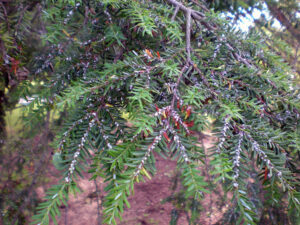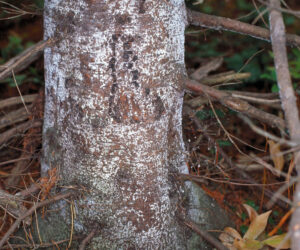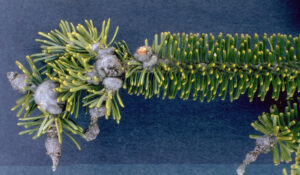
White, cottony hemlock woolly adelgid egg sacs on a hemlock branch. / Photo Credit: Bill McNee, Wisconsin DNR
By Michael Hillstrom, DNR Forest Health Specialist, Fitchburg; Michael.Hillstrom@wisconsin.gov
Hemlock woolly adelgid (HWA) and balsam woolly adelgid (BWA) are invasive, aphid-like insects that cause tree mortality in North America. Neither has been found in Wisconsin so far, but they are likely to arrive at some point, as they have been confirmed in Michigan.
HWA (Adelges tsugae) is an invasive, sucking insect pest of hemlock trees. The white, cottony egg sacs of HWA can be seen on the undersides of hemlock branches at the base of needles year-round. HWA saliva enters the tree while feeding. The saliva is toxic and causes needle drop and twig dieback, progressing to tree mortality in 4-10 years.
Mortality is a concern for forest and landscape hemlocks. For more information, see the Wisconsin Department of Natural Resources (DNR)’s HWA fact sheet.

Balsam woolly adelgids on a balsam fir stem. / Photo Credit: Scott Tunnock, USDA Forest Service, Bugwood.org.
BWA (Adelges piceae) is an invasive, sucking insect pest of true firs (Abies species). In Wisconsin, balsam and Fraser fir are highly susceptible. Symptoms of a BWA attack include stunting and swelling of terminal branches (gouting) caused when BWA injects toxic substances during feeding.
Adult BWA feeding also results in needle discoloration and needle loss. It can cause tree mortality in as little as two years. Mortality is a concern for forest, yard and Christmas fir trees. For more information, visit Michigan’s BWA webpage.
Preventing introduction to Wisconsin is critical because both HWA and BWA are challenging to detect and control. One way to help is to always obtain firewood near where it will be used or use certified firewood that has been properly treated.
Report potential sightings of HWA or BWA in forests to your local forest health specialist. Reports can also be sent to the Wisconsin Department of Agriculture, Trade and Consumer Protection (DATCP) Pest Hotline at 866-440-7523 or DATCPPestHotline@wisconsin.gov.

Closeup photo showing swelling of terminal branches (gouting) caused when balsam woolly adelgid inject toxic substances during tree feeding. / Photo Credit: USDA Forest Service, Bugwood.org
